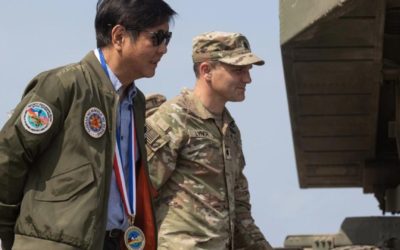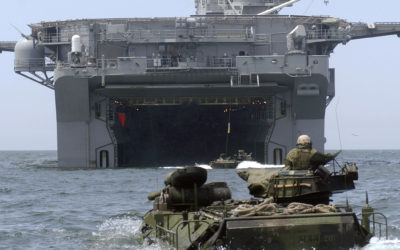On April 26, U.S. President Joe Biden welcomed South Korean President Yoon Suk-yeol to the White House for a summit meeting to celebrate the seventieth anniversary of the U.S.-South Korea alliance and open a new chapter for the next seventy years of expanded cooperation. Amid a substantial list of topics discussed by the two leaders, extended deterrence emerged as the top deliverable.
How Japan Is Doubling Down on Its Military Power
How Japan Is Doubling Down on Its Military Power
How Japan Is Doubling Down on Its Military Power
Japan’s new national security strategy and related defense plans herald a major military modernization effort in response to perceived threats in Northeast Asia, particularly China.
In mid-December, the cabinet of Japanese Prime Minister Kishida Fumio approved the most ambitious and rapid expansion of military power in Japan since the country’s Self-Defense Forces (SDF) were created in 1954. The aim is twofold: bolster Japan’s ability to deter aggression and ensure the SDF are ready to fight should a conflict erupt. Prime Minister Kishida has promised to raise the share of gross domestic product (GDP) dedicated to national security to 2 percent, up from the traditional 1 percent cap of the past four decades.
Three documents were announced that will guide the military’s expansion. The first, a new National Security Strategy [PDF], presents Tokyo’s assessment of the threats arrayed against it and lays out the diplomatic, economic, technological, and military instruments it will employ to address them. The strategy, only the second in Japan’s postwar history, singles out China, North Korea, and Russia for particular concern. Second, a ten-year national defense plan [PDF] outlines the military enhancements required for the SDF to do their job. The menu of defense improvements is comprehensive: the plan calls for a new integrated operational command for the SDF’s three forces, expanded space and cyber capabilities, and the acquisition of long-range strike capabilities. The third document, a five-year procurement plan [PDF in Japanese], outlines the initial priorities for implementing the defense plan. An estimated $320 billion is to be spent in this initial period, which begins next fiscal year and runs through 2027.
What are the most noteworthy aspects of Japan’s new security strategy?
First, and most conspicuous, is the introduction of the long-range conventional strike option. For some years now, Japan has been developing what it calls its “standoff” capability, or the ability to respond to threats in the sea and airspace surrounding the Japanese archipelago. The missiles it has used for coastal defenses have a limited range, around 125 miles (200 kilometers), but new air-to-air missiles purchased from Norway will have a range of over 300 miles (480 kilometers). Japan now will be looking to introduce missiles that have a range of 1,000 miles (1,610 kilometers). These will likely be U.S.-made Tomahawk cruise missiles until Japan is able to build new missiles on its own. These new capabilities will allow Japan to strike targets deep within continental Asia and are intended to make potential aggressors think twice about attacking Japan.
The new strategy also emphasizes the development of Japan’s indigenous technology. The share of the national budget given to innovation will for the first time include technologies required for the country’s defenses, and strategic competition will be one of the drivers of national investment in research and development (R&D). The Ministry of Defense will also be looking to support greater investment in weapons development, both in indigenous production and through international consortia. Missile development will be a priority.
Finally, defense planners have given serious consideration to the SDF’s ability to fight as a cohesive force and sustain operations over the course of a crisis or conflict. Priorities include developing integrated operational planning, including a new joint command, and investing in the forces’ resilience. Making civilian airfields and ports accessible to the SDF, including to their newest platforms such as the F-35 fighter jet as well as destroyers, will go a long way to ensuring readiness. The war in Ukraine has also instilled a sense of urgency in Japan when it comes to securing basic logistical requirements such as fuel, ammunition, and other critical supplies.
Why is Japan making these changes?
This leap in arming the SDF is a product of several factors, the most obvious being the growing presence of foreign militaries in and around Japan. North Korean missiles traverse Japan’s exclusive economic zone and territory frequently and without warning. China’s military regularly operates near Japan’s waters and airspace. And the territorial dispute between Japan and China over the Senkaku/Diaoyu Islands in the East China Sea attracts considerable coast guard and military attention. These apparent threats have been growing since the end of the Cold War, and defense planners have long argued for many of the improvements contained in the new plan.
Meanwhile, the pace of technological change among militaries in the region is accelerating, and Japan has fallen behind. The burgeoning arsenals of missiles in Northeast Asia, now faster, more accurate, and harder to detect, have deepened Japan’s sense of vulnerability. For some time, Tokyo emphasized ballistic missile defenses to cope with this proliferation, but the sheer quantity of missiles in the region now makes it unrealistic to rely on those defenses alone. Moreover, hypersonic glide technology has worsened the situation by rendering incoming missiles virtually undetectable until it is too late. New asymmetric capabilities developed by China also threaten to undercut the United States’ ability to come to Japan’s aid. China’s satellite weaponry, cyber offenses, and surface-to-ship missiles all complicate the traditional division of labor between Japanese and U.S. forces in defending Japan.
The Kishida cabinet’s strategic overhaul not only reveals the conclusions of the defense planning community in Tokyo, it also reflects the growing popular unease in Japan, especially about China. A recent Yomiuri-Gallup poll found that 90 percent of Japanese respondents did not trust China, and 61 percent believed Beijing would invade Taiwan. Indeed, one of the most striking aspects of this 2022 strategic review has been how little opposition the government’s plans have received. Kishida may seem an odd steward of military expansion given his diplomatic experience and deep personal commitment to nuclear disarmament, but he is taking bold steps to ensure that Japan can keep pace with the rapidly shifting military balance. At the same time, he is also deepening Japan’s diplomatic engagement with like-minded countries in the Indo-Pacific and Europe. The only outstanding question is how Japan will finance its military ambition.
Change is coming fast and furious across the globe. The region—indeed the world—looks far more menacing to the Japanese people. The message being sent from Tokyo is that Japan will prepare to act, and act without hesitation, should it need to defend itself.
This article was republished from the Council on Foreign Relations under a Creative Commons license. It does not constitute endorsement of Analyzing War by the author. Read the original article.

Sheila A. Smith is John E. Merow senior fellow for Asia-Pacific studies at the Council on Foreign Relations (CFR). An expert on Japanese politics and foreign policy, she is the author of Japan Rearmed: The Politics of Military Power, Intimate Rivals: Japanese Domestic Politics and a Rising China (released in Japanese as 日中 親愛なる宿敵: 変容する日本政治と対中政策), and Japan’s New Politics and the U.S.-Japan Alliance. She is also the author of the CFR interactive guide Constitutional Change in Japan. Smith is a regular contributor to the CFR blog Asia Unbound and a frequent contributor to major media outlets in the United States and Asia.
Related Articles
President Marcos Jr. Meets With President Biden—But the U.S. Position in Southeast Asia is Increasingly Shaky
Over a four-day visit to Washington, Philippine President Ferdinand Marcos Jr. has been welcomed to the White House and generally feted across Washington. With President Biden, Marcos Jr. (whose father was forced out of office in part through U.S. pressure, and whose family has little love for the United States) affirmed that the two countries are facing new challenges, and Biden said that “I couldn’t think of a better partner to have than [Marcos Jr.].”
The U.S. is about to blow up a fake warship in the South China Sea—but naval rivalry with Beijing is very real and growing
As part of a joint military exercise with the Philippines, the U.S. Navy is slated to sink a mock warship on April 26, 2023, in the South China Sea.
The live-fire drill is not a response to increased tensions with China over Taiwan, both the U.S. and the Philippines have stressed. But, either way, Beijing isn’t happy – responding by holding its own staged military event involving actual warships and fighter jets deployed around Taiwan, a self-governed island that Beijing claims as its own.



